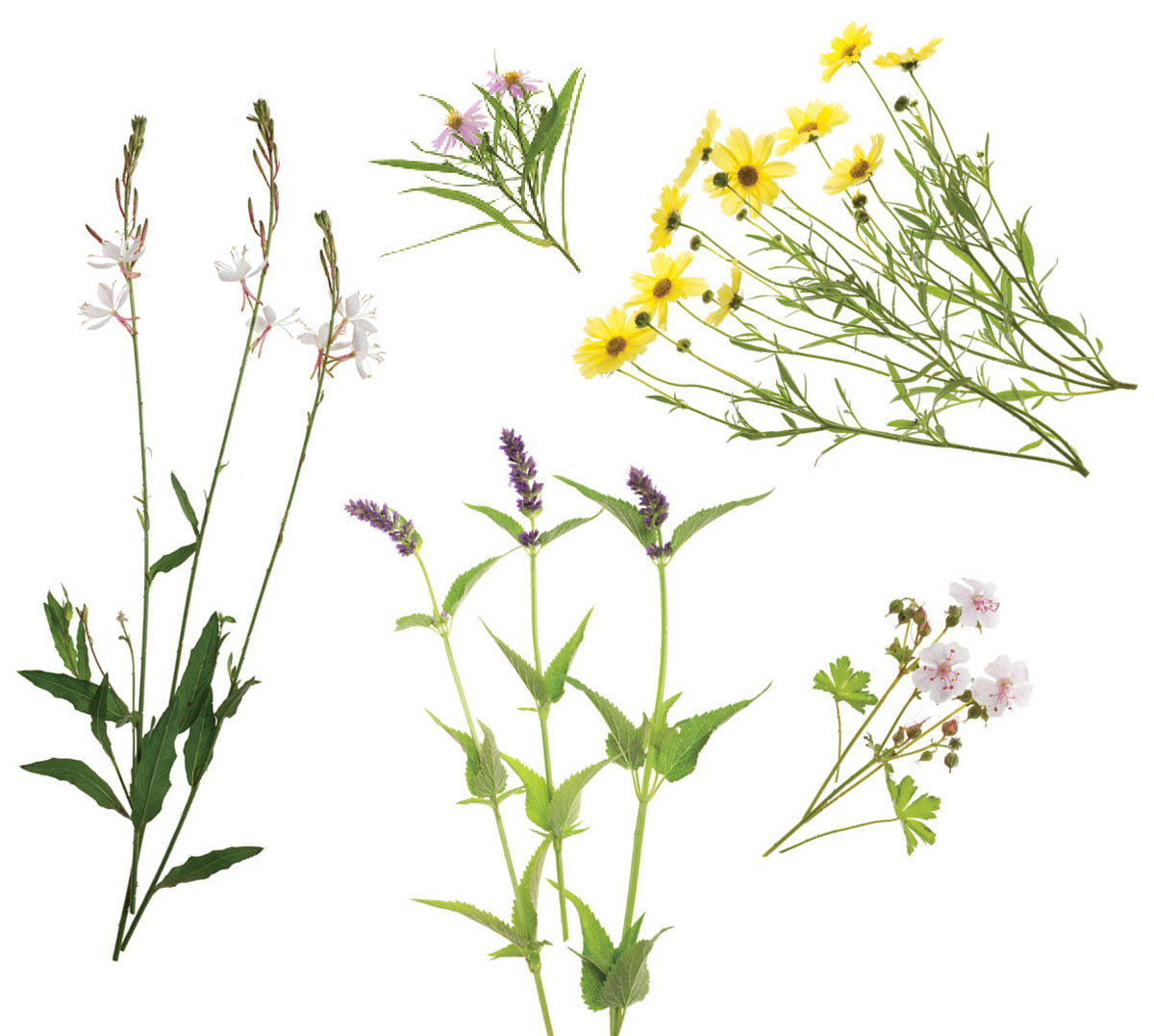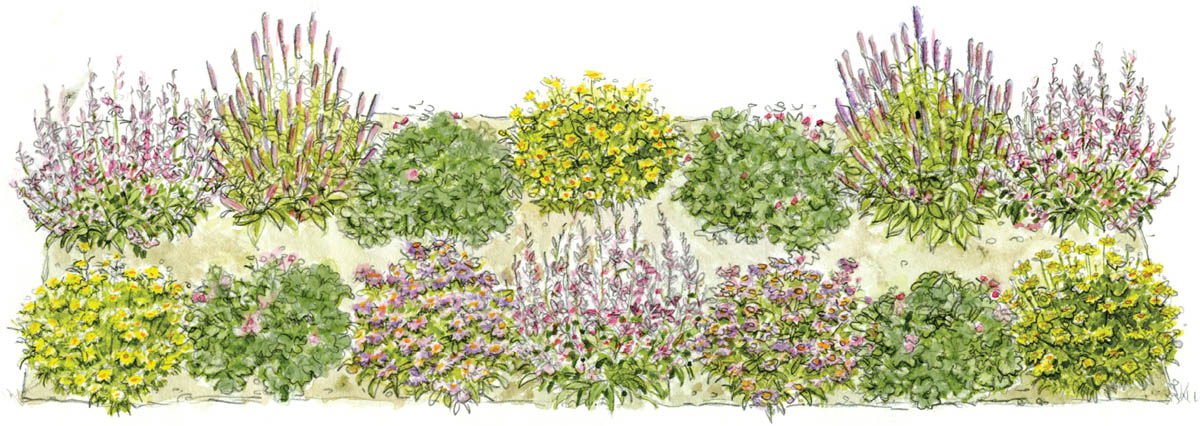Perennials in Pastel
Full sun to partial shade
Average soil

Combining pastel-flowered perennials is a foolproof way to create a gorgeous-looking color-themed garden. No need to worry if you have no design experience, because it’s pretty much impossible for baby blues, lavender-purples, soft yellows, and pastel pinks and peaches to look bad together. Soft colors like these can bleach out in strong light, though, so you may want to put your pastel planting in a site with a bit of shade from midday to midafternoon.
The Garden Plan
Shopping List
1 Blushing Butterflies gaura
Gaura ‘Benso’
3 plants
Zones 5–9
Alternates: Another 1- to 2-foot-tall, upright perennial with pink or peach-colored flowers, such as ‘Pink Mist’ pincushion flower (Scabiosa) [3 plants], ‘Pink Grapefruit’ yarrow (Achillea) [3 plants], or sunset hyssop (Agastache rupestris) [3 plants]

Blushing Butterflies gaura (Gaura ‘Benso’)
2 ‘Black Adder’ hyssop
Agastache
2 plants
Zones 6–9
Alternates: ‘Golden Jubilee’ hyssop, or another 2- to 3-foot-tall, upright perennial with blue or purple-blue flowers, such as ‘Provence’ lavender (Lavandula × intermedia) [2 plants] or ‘Sapphire Blue’ sea holly (Eryngium) [2 plants]

‘Black Adder’ hyssop (Agastache)
3 ‘Biokovo’ geranium
Geranium × cantabrigiense
4 plants
Zones 4–8
Alternates: Another 1- to 2-foot-tall, mounded perennial with pink or peach-colored flowers or foliage, such as ‘Bath’s Pink’ dianthus (Dianthus) [4 plants] or ‘Caramel’ heuchera (Heuchera) [4 plants]

‘Biokovo’ geranium (Geranium × cantabrigiense)
4 ‘Creme Brulee’ coreopsis
Coreopsis verticillata
3 plants
Zones 4–9
Alternates: ‘Moonbeam’ or ‘Moonlight’ coreopsis, or another 1- to 2-foot-tall perennial with yellow flowers, such as lady’s mantle (Alchemilla mollis) [3 plants] or ‘Happy Returns’ daylily (Hemerocallis) [3 plants]

‘Creme Brulee’ coreopsis (Coreopsis verticillata)
5 ‘Wood’s Pink’ aster
Aster
2 plants
Zones 4–8
Alternates: ‘Wood’s Blue’ aster or another 1- to 2-foot-tall, mounded perennial with pink, blue, or purple-blue flowers, such as ‘Blue Ice’ bluestar (Amsonia) [2 plants] or ‘Blue Wonder’ or ‘Kit Kat’ catmint (Nepeta × faassenii) [2 plants]

‘Wood’s Pink’ aster (Aster)
Planting Plan


Season by Season
Spring: ‘Biokovo’ geranium jumps into growth early in the spring, and it may be in bloom by mid spring, with an abundance of pink-and-white flowers. The other perennials are usually just starting to leaf out at that point, in varying shades of green.
Since the geranium begins growing so quickly, give it a bit of attention very early in spring. If there are only a few winter-damaged leaves, clip them off; otherwise, simply shear off all of the leaves close to ground level, being careful not to damage any emerging new shoots. This is also a good time to divide the clumps if they are starting to outgrow their space. Early to mid spring is a fine time to cut down any remaining top growth on the hyssop, coreopsis, and aster, and to divide the clumps (every 3 years or so for the coreopsis and aster; only if the plant is crowding out its companions for the hyssop). Wait until the gaura starts growing before trimming off the dead parts, just above the vigorous new shoots. In mid to late spring, spread a fresh layer of organic mulch over the soil.
Summer: Despite its late start, Blushing Butterflies gaura is generally in bloom by early summer, with white flowers that age to pink. They’re lovely with the butter yellow, daisy-form flowers of ‘Creme Brulee’, which appear around the same time. Both of these may keep blooming all through the summer, or they may take a break in mid or late summer. ‘Black Adder’ hyssop, too, starts flowering in early summer, and its blue-purple spikes continue for months. ‘Biokovo’ geranium overlaps with its companions in early summer, sometimes with a few additional blooms later in the season. ‘Wood’s Pink’ aster finally comes along in late summer, with lots of pink daisies.
Clip off the flower stems on the geranium once the flowers finish. If the gaura or coreopsis clumps stop blooming in mid to late summer, cut them back halfway to encourage more flowers to form later in the season. It’s also a good idea to give the hyssop a light trim (by about a quarter of its height) in late summer, for the same reason. Water the garden during dry spells.
Fall and Winter: This pastel planting continues to look lovely in autumn. ‘Wood’s Pink’ aster flowers into early fall, and the gaura, hyssop, and coreopsis can keep going until frost. ‘Biokovo’ geranium might produce a few flowers now, too, but its main contribution is its leaves, which may turn shades of yellow, orange, and red as colder weather arrives. The geranium and gaura may hold on to their leaves for the winter, too.
No need to do any fall or winter cleanup here. Leaving the top growth in place provides some winter interest from the seed heads and provides some winter protection for the plants, too.
Digging Deeper
- A long, narrow border like this one is great as an edging for a pathway, sidewalk, or driveway, or as a foundation planting around your home, garage, or garden shed. Repeat the plan end to end as many times as needed to fill a longer space, mixing in some of the suggested alternate plants to add more variety. These pastels would show off especially well if you set the garden against a 4- to 6-foot-tall evergreen hedge.
- Rich green leaves make a great backdrop for light-colored blooms, but other leaf colors also have their own charms in a garden like this. Bright yellow or sparkling silver leaves add zip, for instance, while gray or powder blue foliage complements equally soft flower colors.
- There’s plenty of room in this plan for you to tuck in spring-blooming bulbs for early season color, and there are many pastel options that will complement the pale pink ‘Biokovo’ geranium. For early to mid spring, consider light blues, such as ‘Blue Pearl’ crocus (Crocus), ‘Sky Jacket’ Dutch hyacinth (Hyacinthus orientalis), or ‘Valerie Finnis’ grape hyacinth (Muscari). And for mid to late spring, include soft-colored tulips (Tulipa), such as creamy ‘Ivory Floradale’, frilly pink ‘Angelique’, or peachy pink ‘Apricot Beauty’.